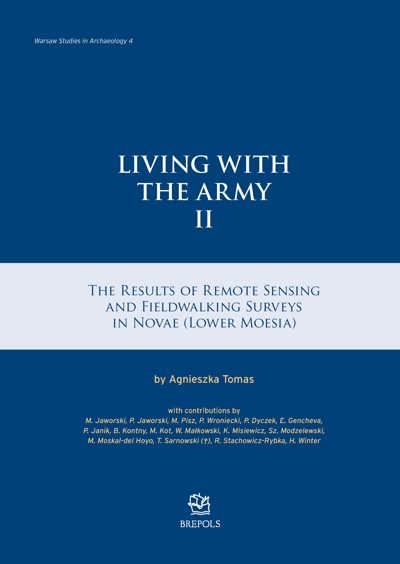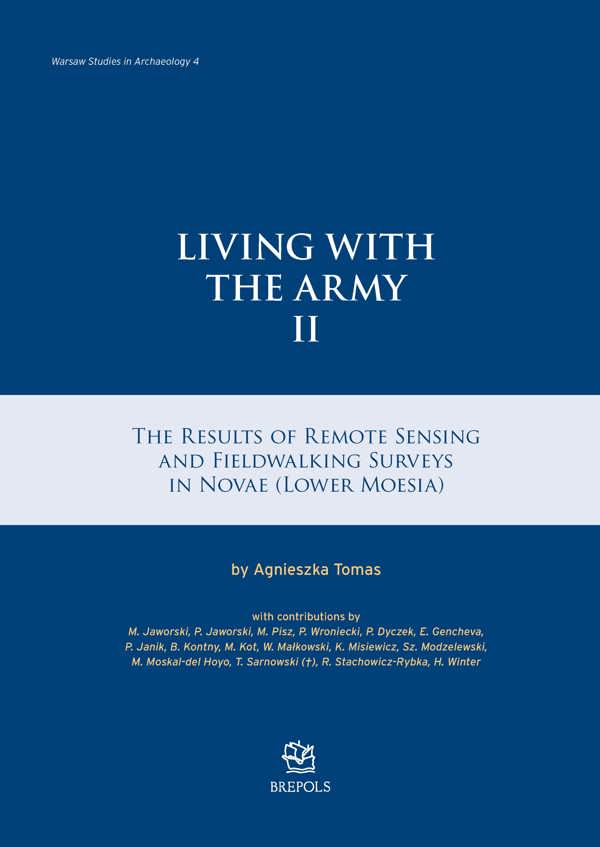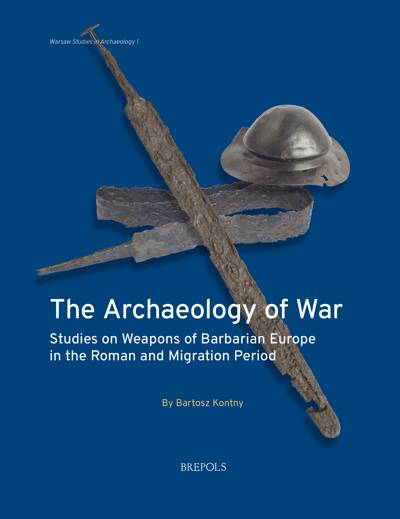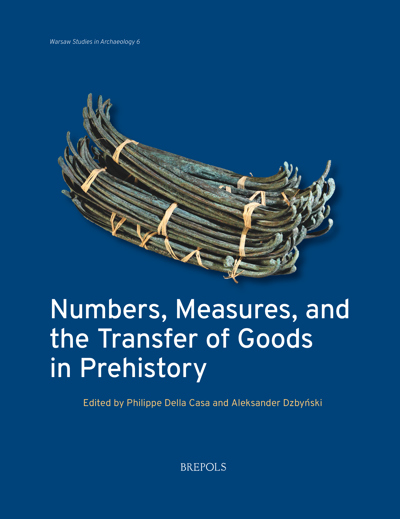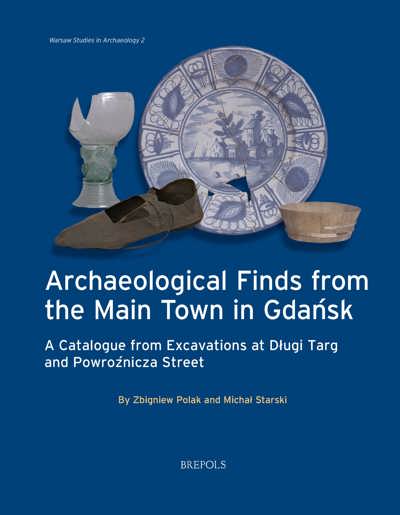
Living with the Army II
The Results of Remote Sensing and Fieldwalking Surveys in Novae (Lower Moesia)
Agnieszka Tomas
- Pages: 261 p.
- Size:210 x 297 mm
- Illustrations:133 b/w, 37 col., 11 tables b/w.
- Language(s):English
- Publication Year:2023
- € 75,00 EXCL. VAT RETAIL PRICE
- ISBN: 978-2-503-60399-5
- Paperback
- Available
- € 75,00 EXCL. VAT RETAIL PRICE
- ISBN: 978-2-503-60401-5
- E-book
- Available
"This research will serve as a crucial reference for scholars in Roman archaeology, frontier history and ancient landscape studies (...). While the book’s primary audience encompasses archaeologists and Roman studies specialists, its broader significance lies in its remarkable illustration of how diverse methodological approaches—from environmental sciences to digital humanities, from anthropological perspectives to advanced computational analyses, and from geological studies to cultural heritage management—can be harmoniously integrated to create a more nuanced and comprehensive understanding of archaeological sites." (Fahri Reza & Faisal Ashaari, Antiquity, 99(404), 2025, 596-597)
Agnieszka Tomas is an Associate Professor in the Chair of Archaeology of Barbaricum and the Roman Provinces in the Faculty of Archaeology, University of Warsaw and the Chief of the Faculty of Archaeology University of Warsaw Archaeological Expedition to Novae. The volume also features contributions by researchers employed at the Faculty of Archaeology, University of Warsaw, and the National Archaeological Institute with Museum, Bulgarian Academy of Sciences.
This book presents the results of a research project realised in 2012-14 in the surroundings of the Roman legionary base at Novae (Moesia inferior), transformed in late Antiquity into a civilian town. The publication also contains material from surveys conducted in 1977 and in 2000, which have so far only been partly published.
Various research methods were implemented jointly to enable at least a partial reconstruction of the settlement’s character. These included geophysical prospection, field walking, and the mapping of metal finds, supplemented by a series of analyses, such as the testing of plant pollen and macroremains, with the aim of providing as complete a reconstruction as possible of the past environment in the fortress’ surroundings. We attempted to record both the finds originating from earlier epochs and those from later ones, in order to provide a more complete reconstruction of the settlement landscape and the character of the site.
Introduction and acknowledgments
I The site and its surroundings (Agnieszka Tomas)
II Introductory remarks on civil settlement near Roman legionary bases and the case of Novae
III The present and the past environment (Magdalena Moskal-del Hoyo, Renata Stachowicz-Rybka, Agnieszka Tomas and Hanna Winter)
1. The environment at present (A. Tomas)
2. Palynological study of the samples from the archaeological site at Novae (Hanna Winter)
3. Plant macro-remains from Novae (Renata Stachowicz-Rybka, Magdalena Moskal-del Hoyo)
IV Research programme (Piotr Jaworski, Marcin Jaworski, Wiesław Małkowski, Krzysztof Misiewicz, Michał Pisz, Agnieszka Tomas, and Piotr Wroniecki)
1. The landscape and research limitations (A. Tomas, P. Wroniecki, M. Jaworski)
2. Organization of work and general settings (A. Tomas)
3. Previous non-intrusive investigations at Novae (A. Tomas, M. Pisz)
4. Field walking surveys and documentation of structural remains (A. Tomas)
5. Geophysical prospection methods (P. Wroniecki, M. Jaworski, M. Pisz, K. Misiewicz, W. Małkowski)
6. Satellite imagery and aerial photography (M. Pisz)
7. Mapping of metal finds (P. Jaworski)
8. GIS database and spatial analyses (P. Wroniecki)
V The results of the prospection (Marcin Jaworski, Wiesław Małkowski, Krzysztof Misiewicz, Michał Pisz, Agnieszka Tomas, and Piotr Wroniecki)
1. Satellite imagery and aerial photography 2011–14 (Michał Pisz)
2. Fortifications’ measurements, field walking, mapping finds and documentation of structural remains (Agnieszka Tomas)
3. Geophysical measurements (P. Wroniecki, M. Jaworski, M. Pisz, K. Misiewicz, W. Małkowski)
VI The finds (Piotr Dyczek, Evgenia Gencheva, Paweł Janik, Bartosz Kontny, Małgorzata Kot, Szymon Modzelewski, Magdalena Moskal-del Hoyo, Tadeusz Sarnowski (†), Renata Stachowicz--Rybka, Agnieszka Tomas and Hanna Winter)
1. Stone Age artefacts (Małgorzata Kot)
2. Pottery (Agnieszka Tomas)
3. Amphorae (Agnieszka Tomas, Piotr Dyczek)
4. Glass finds and evidence of glass manufacturing (Agnieszka Tomas)
5. Weapons, armour and other equipment (Bartosz Kontny)
6. Jewellery and cosmetic items (Evgenia Gencheva, Agnieszka Tomas)
7. Other metal finds (Szymon Modzelewski)
8. Evidence of local metal processing (Szymon Modzelewski)
9. Roman and Early Byzantine coin finds (Piotr Jaworski)
10. Lead seals (Piotr Jaworski)
11. Epigraphic finds (Agnieszka Tomas)
12. Brick and tile-stamps (Tadeusz Sarnowski (†))
13. Terracotta and ceramic items (Agnieszka Tomas)
14. Stone finds (Agnieszka Tomas)
15. Medieval and post-Medieval pottery (Paweł Janik)
16. Medieval coins found at Ostrite Mogili (Piotr Jaworski)
17. Medieval heart-shaped copper alloy find from Ostrite Mogili (Paweł Janik)
VII Summary and conclusions (Agnieszka Tomas)
Literature
List of figures and tables in the text
